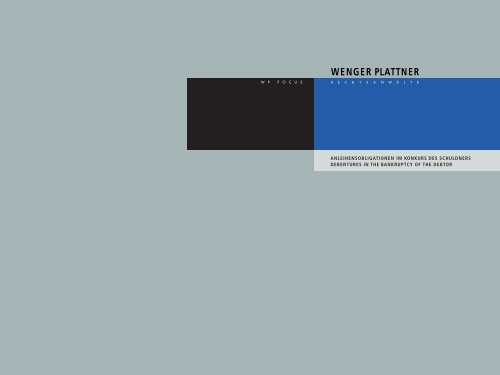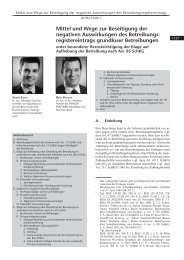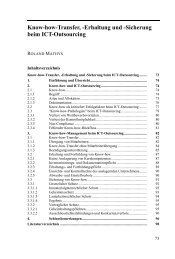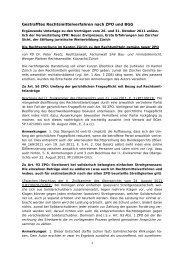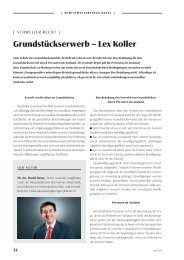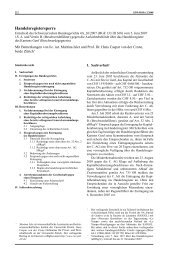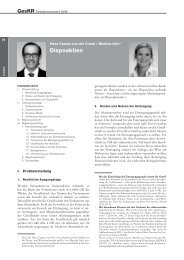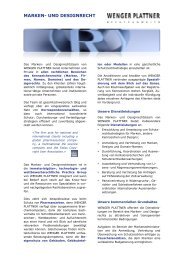Anleihenobligationen im Konkurs des Schuldners - Wenger Plattner
Anleihenobligationen im Konkurs des Schuldners - Wenger Plattner
Anleihenobligationen im Konkurs des Schuldners - Wenger Plattner
Erfolgreiche ePaper selbst erstellen
Machen Sie aus Ihren PDF Publikationen ein blätterbares Flipbook mit unserer einzigartigen Google optimierten e-Paper Software.
64036pb_Focus_Umschlag_d/e 24.9.2008 14:50 Uhr Seite 1<br />
W P F O C U S<br />
ANLEIHENSOBLIGATIONEN IM KONKURS DES SCHULDNERS<br />
DEBENTURES IN THE BANKRUPTCY OF THE DEBTOR
64036pb_Focus_Umschlag_d/e 24.9.2008 14:50 Uhr Seite 2<br />
■ BASEL<br />
WENGER PLATTNER<br />
Advokatur und Notariat<br />
Aeschenvorstadt 55<br />
CH-4010 Basel<br />
Telefon +41- 61-279 70 00<br />
Telefax +41- 61-279 70 01<br />
basel@wenger-plattner.ch<br />
www.wenger-plattner.ch<br />
■ ZÜRICH<br />
WENGER PLATTNER<br />
Rechtsanwälte<br />
Goldbach-Center<br />
Seestrasse 39<br />
Bahnhof<br />
Zürich<br />
S-Bahn<br />
Stadelhofen<br />
Tiefenbrunnen<br />
S-Bahn<br />
Zollikerberg<br />
Zumikon<br />
CH-8700 Küsnacht-Zürich<br />
Telefon +41-1-914 27 70<br />
Telefax +41-1-914 27 88<br />
zuerich@wenger-plattner.ch<br />
Wollishofen<br />
Zollikon<br />
Station<br />
Goldbach<br />
Küsnacht<br />
www.wenger-plattner.ch<br />
Kilchberg<br />
■ BERN<br />
WENGER PLATTNER<br />
Rechtsanwälte<br />
Jungfraustrasse 1<br />
CH-3000 Bern 6<br />
Bahnhof<br />
Bern<br />
Bärenplatz<br />
Zytgloggeturm<br />
Telefon +41- 31-356 49 43<br />
Münster<br />
Telefax +41- 31-351 28 83<br />
bern@wenger-plattner.ch<br />
Bun<strong>des</strong>haus<br />
www.wenger-plattner.ch<br />
Helvetiaplatz<br />
WP
64036pb_Focus_Inhalt_d/e 24.9.2008 14:49 Uhr Seite 1<br />
ANLEIHENSOBLIGATIONEN IM KONKURS DES SCHULDNERS<br />
LIC. IUR. KARL WÜTHRICH<br />
Konsequenzen der Wahl oder Nichtwahl eines<br />
gemeinsamen Vertreters nach Art. 1183 OR<br />
Im <strong>Konkurs</strong> <strong>des</strong> <strong>Schuldners</strong> haben die Gläubiger<br />
einer Anleihensobligation die Möglichkeit, einen<br />
Anleihensvertreter zu wählen und ihm Vollmacht<br />
zur einheitlichen Wahrung ihrer Rechte zu erteilen.<br />
Der Entscheid der Anleihensgläubiger beeinflusst<br />
den Ablauf <strong>des</strong> <strong>Konkurs</strong>verfahrens in nicht<br />
unerheblichem Ausmass. Die Kollokation der<br />
Anleihensgläubiger gestaltet sich anders, wenn ein<br />
Anleihensvertreter gewählt wird. Entsprechend<br />
sind auch die Abläufe bei der Rechtswahrung der<br />
Anleihensgläubiger bei Kollokationsklagen, bei<br />
der Abtretung von Prozessführungsrechten <strong>im</strong><br />
Sinne von Art.260 SchKG oder in der zweiten<br />
<strong>Konkurs</strong>gläubigerversammlung unterschiedlich. Im<br />
nachfolgenden Artikel werden diese Unterschiede<br />
<strong>im</strong> Einzelnen dargestellt.<br />
1. EINFÜHRUNG<br />
Werden von einem privaten Schuldner mit Sitz<br />
oder geschäftlicher Niederlassung in der Schweiz<br />
Anleihensobligationen mit einheitlichen Bedingungen<br />
durch öffentliche Zeichnung ausgegeben,<br />
so bilden die Gläubiger jeder einzelnen Anleihe<br />
je eine Gläubigergemeinschaft (Art. 1157 OR).<br />
Eine solche Gläubigergemeinschaft ist keine juristische<br />
Person und damit auch nicht rechtsfähig.<br />
Im Rahmen der ihr durch das Gesetz verliehenen<br />
Befugnisse (Art. 1164 OR) wird ihr aber Parteifähigkeit<br />
zuerkannt 1 . Gerät der Anleihensschuldner<br />
in <strong>Konkurs</strong>, so kann eine einzuberufende<br />
Versammlung der Anleihensgläubiger einem gemeinsamen<br />
Vertreter eine Vollmacht zur einheitlichen<br />
Wahrung der Rechte der Anleihensgläubiger<br />
<strong>im</strong> <strong>Konkurs</strong>verfahren erteilen (Art. 1183 OR).<br />
Je nachdem, ob ein gemeinsamer Vertreter gewählt<br />
1<br />
BGE 113 II 285<br />
1
64036pb_Focus_Inhalt_d/e 24.9.2008 14:49 Uhr Seite 2<br />
A N L E I H E N S O B L I G A T I O N E N<br />
I M K O N K U R S D E S S C H U L D N E R S<br />
wird oder nicht, gestaltet sich die Wahrung der<br />
Rechte der Anleihensgläubiger <strong>im</strong> <strong>Konkurs</strong> <strong>des</strong><br />
<strong>Schuldners</strong> unterschiedlich.<br />
Öffentlich ausgegebene Anleihensobligationen<br />
sind heute regelmässig börsenkotiert. Die Erfahrung<br />
zeigt, dass der Börsenhandel nach der <strong>Konkurs</strong>eröffnung<br />
über den Schuldner nicht automatisch<br />
eingestellt wird. Die Zusammensetzung<br />
der Anleihensgläubiger verändert sich durch den<br />
Börsenhandel laufend, ohne dass die <strong>Konkurs</strong>verwaltung<br />
davon Kenntnis erlangt. Wenn die<br />
Anleihensgläubiger keinen gemeinsamen Vertreter<br />
bestellt haben, so ergeben sich daraus Probleme bei<br />
der Erstellung <strong>des</strong> Kollokationsplanes.<br />
2. DIE VERSAMMLUNG DER<br />
ANLEIHENSGLÄUBIGER<br />
Gemäss Art. 1183 Abs. 1 OR hat die <strong>Konkurs</strong>verwaltung<br />
unverzüglich eine Versammlung der Anleihensgläubiger<br />
einzuberufen. Im ordentlichen<br />
<strong>Konkurs</strong>verfahren wird die <strong>Konkurs</strong>verwaltung<br />
erst an der ersten <strong>Konkurs</strong>gläubigerversammlung<br />
gewählt (Art. 237 Abs. 2 SchKG). Entsprechend<br />
wird in der Lehre die Meinung vertreten, die Versammlung<br />
der Anleihensgläubiger könne erst nach<br />
der ersten <strong>Konkurs</strong>gläubigerversammlung stattfinden<br />
2 . Meines Erachtens darf der Gesetzestext<br />
in Bezug auf den Zeitpunkt der Versammlung der<br />
Anleihensgläubiger nicht eng ausgelegt werden.<br />
Ist vor der <strong>Konkurs</strong>eröffnung <strong>im</strong> Zusammenhang<br />
mit einem Sanierungsverfahren eine Versammlung<br />
abgehalten worden und hat diese für den Fall eines<br />
<strong>Konkurs</strong>es einen gemeinsamen Vertreter zur Wahrung<br />
der Interessen <strong>im</strong> <strong>Konkurs</strong> bestellt, so muss<br />
dieser Vertreter ab <strong>Konkurs</strong>eröffnung für die<br />
Anleihensgläubigergemeinschaft handeln können.<br />
Es würde den Interessen der Anleihensgläubiger<br />
und dem Sinn von Art. 1183 OR widersprechen,<br />
wenn der Vertreter seine Vollmacht bis zu einer<br />
Bestätigung in einer weiteren Versammlung der<br />
Anleihensgläubiger nach der ersten <strong>Konkurs</strong>gläubigerversammlung<br />
nicht ausüben könnte 3 . Ebenso<br />
ist nicht einzusehen, weshalb in einer Versammlung<br />
der Anleihensgläubiger, die noch vor der<br />
<strong>Konkurs</strong>eröffnung einberufen wurde, aber erst<br />
nach der <strong>Konkurs</strong>eröffnung stattfindet, nicht bereits<br />
vor der ersten <strong>Konkurs</strong>gläubigerversammlung<br />
über die Wahl eines Anleihensvertreters verhandelt<br />
und abgest<strong>im</strong>mt werden kann. Durch einen<br />
gemeinsamen Vertreter wird die Stellung der Anleihensgläubiger<br />
auch in der ersten <strong>Konkurs</strong>gläubigerversammlung<br />
gestärkt, weil sie einheitlich<br />
auftreten können.<br />
Die Wahl eines gemeinsamen Vertreters bedarf der<br />
Zust<strong>im</strong>mung von mehr als der Hälfte <strong>des</strong> <strong>im</strong> Umlauf<br />
befindlichen Anleihenskapitals (Art. 1180<br />
OR). Für die Durchführung der Versammlung<br />
der Anleihensgläubiger gelten <strong>im</strong> Übrigen die Best<strong>im</strong>mungen<br />
der Art. 1164 ff. OR entsprechend.<br />
Insbesondere hat jeder Anleihensgläubiger die<br />
Möglichkeit, deren Beschlüsse gemäss Art. 1182<br />
OR anzufechten.<br />
3. ES WIRD KEIN GEMEINSAMER<br />
VERTRETER GEWÄHLT<br />
3.1. GRUNDSATZ<br />
In diesem Fall hat jeder Anleihensgläubiger seine<br />
Rechte <strong>im</strong> <strong>Konkurs</strong> <strong>des</strong> <strong>Schuldners</strong> selbständig<br />
wahrzunehmen (Art. 1183 Abs. 2 OR). Die Anleihensgläubiger<br />
werden gleich behandelt wie alle<br />
übrigen <strong>Konkurs</strong>gläubiger. Hinsichtlich der Kollo-<br />
2<br />
A. Ziegler, Kommentar zum Schweizerischen Zivilgesetzbuch,<br />
Obligationenrecht, 19. Titel, Anleihensobligationen, N 2 zu Art.<br />
1183 OR; Ch. Steinmann in Kommentar zum Schweizerischen<br />
Privatrecht, Obligationenrecht II, N 3 zu Art. 1183.<br />
3<br />
A. Ziegler, a.a.O., N 3 zu Art. 1183 OR<br />
2
64036pb_Focus_Inhalt_d/e 24.9.2008 14:49 Uhr Seite 3<br />
kation der Anleihensgläubiger ergeben sich daraus<br />
die nachfolgend dargestellten Konsequenzen.<br />
3.2 KOLLOKATION DER<br />
ANLEIHENSGLÄUBIGER<br />
Im Kollokationsplan sind die Gläubiger namentlich<br />
aufzuführen. Eine Kollokation auf den «Inhaber» ist<br />
nicht statthaft. Die <strong>Konkurs</strong>verwaltung und die<br />
übrigen Gläubiger müssen jede angemeldete Forderung<br />
– auch Verrechnungseinreden – überprüfen<br />
und allenfalls abweisen respektive durch Kollokationsklage<br />
anfechten können 4 . Dieser Grundsatz<br />
gilt auch für die Kollokation der Anleihensgläubiger.<br />
Jeder dieser Gläubiger ist mit seinem Anteil an<br />
der Anleihensobligation mit Nennung <strong>des</strong><br />
Namens in den Kollokationsplan aufzunehmen.<br />
Die in der Anleihe verkörperte Inhaberpapierforderung<br />
wird dadurch in eine Namenpapierforderung<br />
umgewandelt 5 . Die Übertragung der Forderung<br />
aus der Anleihensobligation kann dann nur<br />
noch durch Zession der Forderung und Übergabe<br />
der Obligation an den Erwerber erfolgen. Anspruch<br />
auf die <strong>Konkurs</strong>dividende hat nur der<br />
kollozierte Anleihensgläubiger oder ein Dritter,<br />
der sich durch Vorlage einer Zessionserklärung als<br />
<strong>des</strong>sen Rechtsnachfolger legit<strong>im</strong>iert 6 .<br />
Jeder Anleihensgläubiger ist somit verpflichtet, seine<br />
Forderungen unter Bekanntgabe seiner Identität<br />
anzumelden. Die Anmeldung durch einen<br />
Stellvertreter ohne Bekanntgabe <strong>des</strong> Gläubigers<br />
ist unzulässig. Wird die Bekanntgabe der Identität<br />
<strong>des</strong> Gläubigers verweigert, so ist die Anmeldung<br />
zurückzuweisen. Auf sie darf nicht eingetreten werden;<br />
über Zulassung oder Abweisung der an-gemeldeten<br />
Forderung kann nicht entschieden werden<br />
7 . Anleihensgläubiger, die ihre Forderungen<br />
nicht anmelden, nehmen am <strong>Konkurs</strong> ebenfalls<br />
nicht teil 8 .<br />
Jeder Gläubiger ist verpflichtet, den Bestand seiner<br />
Forderungen nachzuweisen und der <strong>Konkurs</strong>verwaltung<br />
die entsprechenden Beweismittel einzureichen<br />
(Art. 232 Abs. 2 Ziff. 2 SchKG). Die Inhaberobligation<br />
verkörpert das Forderungsrecht <strong>des</strong> Anleihensgläubigers.<br />
Mit der <strong>Konkurs</strong>eröffnung wird<br />
die Anleihensforderung fällig (Art. 208 SchKG).<br />
Die Anmeldung der Forderung <strong>im</strong> <strong>Konkurs</strong> ist eine<br />
Inkassohandlung. Entsprechend kann die <strong>Konkurs</strong>verwaltung<br />
nach den wertpapierrechtlichen<br />
Grundsätzen die Vorlage der Originalurkunde fordern<br />
9 . Insbesondere bei an der Börse<br />
gehandelten Anleihen wird die <strong>Konkurs</strong>verwaltung<br />
nicht darum herumkommen, die Einreichung der<br />
Obligationen zu verlangen. Andernfalls riskiert sie,<br />
dass der Kollokationsplan <strong>im</strong> Zeitpunkt der Auflage<br />
nicht mehr den tatsächlichen Verhältnissen entspricht.<br />
Be<strong>im</strong> Einzug der Obligationen sollte allerdings<br />
auf die aktuelle Praxis <strong>im</strong><br />
Wertschriftenhandel Rücksicht genommen werden.<br />
Heute werden Obligationen regelmässig ohne<br />
Papierverkehr gehandelt. Die Originaltitel sind bei<br />
der SIS Segaintersettle AG deponiert. Die Anteile<br />
der einzelnen Anleihensgläubiger werden nur<br />
buchmässig erfasst. Entsprechend sind die Anleihensgläubiger<br />
nicht in der Lage, eine ihren<br />
Anteil an der Anleihensobligation verkörpernde<br />
Originalobligation vorzuweisen. Die Problematik<br />
kann dadurch gelöst werden, dass die Einlieferung<br />
der Obligationen über das Clearingsystem der<br />
Banken in ein Bankdepot der <strong>Konkurs</strong>masse ermöglicht<br />
wird.<br />
4<br />
BGE 57 III 134 f.<br />
5<br />
BGE 42 III 387 f.<br />
6<br />
BGE 42 III 388<br />
7<br />
Fritsche/Walder, Schuldbetreibung und <strong>Konkurs</strong> nach<br />
Schweizerischem Recht, Band II, § 46, N 3a; BGE 57 III 135<br />
8<br />
Dieter Hierholzer, in Kommentar zum Bun<strong>des</strong>gesetz über<br />
Schuldbetreibung und <strong>Konkurs</strong>, N 3 zu Art. 244 SchKG<br />
9<br />
Meier/Hayoz/von der Crone, Das Wertpapierrecht, S. 34<br />
3
64036pb_Focus_Inhalt_d/e 24.9.2008 14:49 Uhr Seite 4<br />
A N L E I H E N S O B L I G A T I O N E N<br />
I M K O N K U R S D E S S C H U L D N E R S<br />
3.3 DER KONKURS DER BIBER HOLDING AG<br />
ALS ANWENDUNGSFALL<br />
Bei der Biber Holding AG waren <strong>im</strong> Zeitpunkt<br />
der <strong>Konkurs</strong>eröffnung <strong>im</strong> Januar 1997 vier Anleihensobligationen<br />
mit unterschiedlichen Bedingungen<br />
über insgesamt rund CHF 100 Mio. ausstehend.<br />
Alle Anleihen waren börsenkotiert. Der<br />
Börsenhandel wurde nach der <strong>Konkurs</strong>eröffnung<br />
nicht eingestellt. Die durchgeführten Versammlungen<br />
der Anleihensgläubiger aller vier Anleihen<br />
wählten keine gemeinsamen Vertreter. Im Hinblick<br />
auf die geplante Auflage <strong>des</strong> Kollokationsplanes<br />
<strong>im</strong> Frühjahr 1998 forderte die <strong>Konkurs</strong>verwaltung<br />
die bekannten Obligationäre auf, die Obligationen<br />
einzureichen. Die Einreichung konnte durch Zustellung<br />
der physischen Originaltitel an die <strong>Konkurs</strong>verwaltung<br />
oder durch Einlieferung der Obligationen<br />
über das Clearingsystem der Banken in<br />
ein Depot der <strong>Konkurs</strong>masse der Biber Holding<br />
AG bei der Zürcher Kantonalbank erfolgen.<br />
Gleichzeitig wurde ein letzter Schuldenruf mit der<br />
gleichen Aufforderung publiziert. Über 900 Obligationäre<br />
mit rund 99% <strong>des</strong> ausstehenden Anleihenskapitals<br />
reichten ihre Obligationen ein. Der<br />
Börsenhandel wurde aufgrund eines Gesuchs der<br />
<strong>Konkurs</strong>verwaltung per Ende November 1997 eingestellt.<br />
Das Kollokationsverfahren konnte <strong>im</strong><br />
Frühjahr 1998 ohne Schwierigkeiten abgewickelt<br />
werden.<br />
4. DIE ANLEIHENSGLÄUBIGER WÄHLEN<br />
EINEN GEMEINSAMEN VERTRETER<br />
diejenigen Handlungen, die diesem Zweck dienen.<br />
Darunter fallen die Anmeldung der Forderung aus<br />
der Anleihensobligation bei der <strong>Konkurs</strong>verwaltung,<br />
die Kollokationsklage auf Zulassung gegen<br />
die <strong>Konkurs</strong>masse bzw. die Verteidigung gegen<br />
Kollokationsklagen anderer Gläubiger sowie die<br />
Vertretung der Anleihensgläubiger an der zweiten<br />
<strong>Konkurs</strong>gläubigerversammlung 10 . Ohne ausdrücklichen<br />
Beschluss der Versammlung der Anleihensgläubiger<br />
besitzt der Vertreter keine weitergehende<br />
Vollmacht. Insbesondere kann er <strong>im</strong> Kollokationsverfahren<br />
oder bei der Abtretung von<br />
Prozessführungsrechten gemäss Art. 260 SchKG<br />
Klagen für die Anleihensgläubigergemeinschaft<br />
nur zur vorsorglichen Wahrung von angesetzten<br />
Fristen einreichen 11 .<br />
4.2 KOLLOKATION DER<br />
ANLEIHENSOBLIGATION<br />
Der Anleihensvertreter meldet die gesamte Anleihensforderung<br />
namens der Anleihensgläubigergemeinschaft<br />
an. Er braucht die Namen der<br />
einzelnen Anleihensgläubiger nicht zu nennen.<br />
Ebensowenig hat er als Nachweis der Anleihensforderung<br />
die Obligationen einzureichen 12 . Die<br />
Anleihensgläubigergemeinschaft als solche wird <strong>im</strong><br />
Kollokationsplan aufgeführt. Die einzelnen An-leihensgläubiger<br />
können anonym bleiben. Entsprechend<br />
können allfällige Einreden – zum Beispiel<br />
diejenige der Verrechnung – gegen einzelne Anleihensgläubiger<br />
<strong>im</strong> Zeitpunkt der Kollokation von<br />
der <strong>Konkurs</strong>verwaltung oder von Drittgläubigern<br />
nicht geprüft und vorgebracht werden.<br />
4.1 INHALT DER VOLLMACHT DES<br />
GEMEINSAMEN VERTRETERS<br />
Gemäss dem Wortlaut von Art. 1183 Abs. 1 OR<br />
wird dem Anleihensvertreter die Vollmacht zum<br />
Zweck der «einheitlichen Wahrung der Rechte der<br />
Anleihensgläubiger» erteilt. Sie umfasst somit nur<br />
10<br />
A. Ziegler, a.a.O., N 6 und 7 zu Art. 1183 OR; Ch. Steinmann,<br />
a.a.O., N 5 und 6 zu Art. 1183 OR<br />
11<br />
A. Ziegler, a.a.O., N 7 zu Art. 1183 OR; Ch. Steinmann,<br />
a.a.O., N 6 zu Art. 1183 OR<br />
12<br />
A. Ziegler, a.a.O., N 7 zu Art. 1183 OR<br />
4
64036pb_Focus_Inhalt_d/e 24.9.2008 14:49 Uhr Seite 5<br />
4.3 STIMMRECHT DES GEMEINSAMEN<br />
VERTRETERS AN DER ZWEITEN<br />
KONKURSGLÄUBIGERVERSAMMLUNG<br />
Unterschiedlich beantwortet wird in der Lehre<br />
die Frage, wie viele St<strong>im</strong>men der Vertreter einer<br />
Anleihensgläubigergemeinschaft an der zweiten<br />
<strong>Konkurs</strong>gläubigerversammlung vertritt 13 . Bei der<br />
Beantwortung der Frage sind meines Erachtens<br />
einerseits die Interessen der Anleihensgläubiger,<br />
andererseits aber auch das Interesse aller <strong>Konkurs</strong>gläubiger<br />
an einer geordneten Abwicklung <strong>des</strong><br />
<strong>Konkurs</strong>verfahrens zu berücksichtigen.<br />
Die Meinung, der Vertreter könne nur so viele<br />
St<strong>im</strong>men vertreten, wie er in der Versammlung der<br />
Anleihensgläubiger erhalten habe, kann nicht<br />
überzeugen. Insbesondere die Interessen derjenigen<br />
Anleihensgläubiger, die an der Versammlung<br />
teilgenommen und der Vollmachtserteilung nicht<br />
zugest<strong>im</strong>mt haben, werden mit dieser Lösung nicht<br />
berücksichtigt. Diese Anleihensgläubiger sind von<br />
der Teilnahme an der zweiten <strong>Konkurs</strong>gläubigerversammlung<br />
ausgeschlossen, weil der Anleihensvertreter<br />
die Interessen der Anleihensgläubigergemeinschaft<br />
einheitlich vertritt. Trotzdem hätte<br />
der Anleihensvertreter kein St<strong>im</strong>mrecht für die<br />
ausgeschlossenen Gläubiger.<br />
Die Ansicht, der Anleihensvertreter vertrete so<br />
viele St<strong>im</strong>men, wie Anleihensgläubiger vorhanden<br />
sind, dürfte regelmässig nicht durchführbar sein.<br />
Die Anzahl der Anleihensgläubiger kann sich laufend<br />
verändern, ohne dass die <strong>Konkurs</strong>verwaltung<br />
oder der Vertreter der Anleihensgläubigergemeinschaft<br />
davon Kenntnis erhält. Dies ist insbesondere<br />
bei breitgestreuten, börsenkotierten Obligationen<br />
der Fall. Auch mit grossem Aufwand dürfte<br />
es dem Anleihensvertreter nicht möglich sein,<br />
laufend den Nachweis über die effektive Anzahl<br />
der Anleihensgläubiger zu erbringen. Der Fall der<br />
Biber Holding AG zeigt, dass sich nicht einmal<br />
bei einem Einzug der Obligationen alle Anleihensgläubiger<br />
bei der <strong>Konkurs</strong>verwaltung melden. Die<br />
Anzahl der vom Anleihensvertreter vertretenen<br />
St<strong>im</strong>men würde von Zufälligkeiten abhängen und<br />
wäre je nach Zeitpunkt der zweiten <strong>Konkurs</strong>gläubigerversammlung<br />
unterschiedlich. Bei allfälligen<br />
Zirkularbeschlüssen würde sich die Anzahl seiner<br />
St<strong>im</strong>men von Fall zu Fall verändern. Damit wäre<br />
eine geordnete Abwicklung <strong>des</strong> <strong>Konkurs</strong>verfahrens<br />
gefährdet.<br />
Meines Erachtens werden mit der folgenden Lösung<br />
sowohl die Interessen der Anleihensgläubigergemeinschaft<br />
als auch diejenigen aller <strong>Konkurs</strong>gläubiger<br />
am besten berücksichtigt: Die Anzahl<br />
der vom Anleihensvertreter vertretenen St<strong>im</strong>men<br />
entspricht der Anzahl der Anleihensgläubiger, die<br />
an der Versammlung der Anleihensgläubiger teilnehmen<br />
oder vertreten werden. Diese St<strong>im</strong>menzahl<br />
bleibt für die ganze Dauer <strong>des</strong> <strong>Konkurs</strong>verfahrens<br />
unverändert. Einerseits kann so jeder<br />
Anleihensgläubiger dafür sorgen, dass seine<br />
St<strong>im</strong>me <strong>im</strong> <strong>Konkurs</strong> vertreten wird. Andererseits<br />
kennen die übrigen Gläubiger und die <strong>Konkurs</strong>verwaltung<br />
nach der Durchführung der Versammlung<br />
der Anleihensgläubiger die definitive St<strong>im</strong>menzahl<br />
<strong>des</strong> Anleihensvertreters. Es dürfte<br />
angezeigt sein, in der Einladung zur Versammlung<br />
der Anleihensgläubiger (Publikation) auf diese Art<br />
der Festlegung <strong>des</strong> St<strong>im</strong>mrechts eines allfälligen<br />
Anleihensvertreters hinzuweisen.<br />
4.4 KOLLOKATIONSKLAGEN UND<br />
ABTRETUNGSBEGEHREN IM SINNE<br />
VON ART. 260 SCHKG<br />
Die Anleihensgläubigergemeinschaft ist zwar für<br />
die Einleitung eines Kollokationsprozesses gegen<br />
einen anderen Gläubiger oder die klageweise<br />
Weiterverfolgung eines Anspruchs der <strong>Konkurs</strong>masse<br />
nach Abtretung <strong>des</strong> Prozessführungsrechts<br />
13<br />
A. Rohr, Grundzüge <strong>des</strong> Emissionsrechts, S. 292; A. Ziegler,<br />
a.a.O., N 6 zu Art. 1183 OR; Ch. Steinmann, a.a.O.,<br />
N 5 zu Art. 1183 OR<br />
5
64036pb_Focus_Inhalt_d/e 24.9.2008 14:49 Uhr Seite 6<br />
A N L E I H E N S O B L I G A T I O N E N<br />
I M K O N K U R S D E S S C H U L D N E R S<br />
<strong>im</strong> Sinne von Art. 260 SchKG prozessfähig und<br />
aktiv legit<strong>im</strong>iert 14 . Der Anleihensvertreter ist<br />
ohne Spezialvollmacht dagegen nicht berechtigt,<br />
die Anleihensgläubigergemeinschaft in solchen<br />
Prozessen zu vertreten. Nur zur Wahrung von angesetzten<br />
kurzen Fristen (Art. 250 SchKG) kann er<br />
in solchen Fällen vorsorglicherweise eine Klage für<br />
die Anleihensgläubigergemeinschaft einreichen 15 .<br />
Anschliessend hat eine Versammlung der Anleihensobligationäre<br />
darüber zu entscheiden, ob<br />
der Anleihensvertreter für die Weiterführung <strong>des</strong><br />
Prozesses für die Anleihensgläubigergemeinschaft<br />
bevollmächtigt wird. Kommt eine Vollmachtserteilung<br />
nicht zustande, so müssen einzelne Anleihensgläubiger<br />
die Möglichkeit haben, den Prozess<br />
selber weiterzuführen 16 . Diese Anleihensgläubiger<br />
können nicht mehr als Anleihensgläubigergemeinschaft<br />
auftreten. Sie müssen den Prozess in<br />
eigenem Namen und auf eigene Rechnung führen.<br />
Wie weisen die Anleihensgläubiger nun ihre<br />
Aktivlegit<strong>im</strong>ation nach? Wie wird sichergestellt,<br />
dass über einen allfälligen Prozessgewinn <strong>im</strong> Sinne<br />
der Art. 250 Abs. 2 resp. Art 260 Abs. 2 SchKG abgerechnet<br />
werden kann? Weder die einzelnen Anleihensgläubiger<br />
noch ihre Forderungen sind aus<br />
dem Kollokationsplan ersichtlich. Meines<br />
Erachtens können diese Probleme mit folgendem<br />
Vorgehen gelöst werden: Die Anleihensgläubiger,<br />
die einen Prozess weiterführen wollen, haben ihre<br />
Forderungen ordnungsgemäss (siehe Ziff. 3.2 vorstehend)<br />
bei der <strong>Konkurs</strong>verwaltung anzumelden<br />
und durch Einreichung der Obligationen nachzuweisen.<br />
Der Kollokationsplan wird wie folgt angepasst:<br />
Diese Anleihensgläubiger werden aus der<br />
Anonymität der Anleihensgläubigergemeinschaft<br />
heraus gelöst und separat unter eigenem Namen<br />
mit ihren Forderungen in den Kollokationsplan<br />
aufgenommen. Damit sind die Anleihensgläubiger<br />
in der Lage, ihre Aktivlegit<strong>im</strong>ation nachzuweisen,<br />
und die <strong>Konkurs</strong>verwaltung kann die Abrechnung<br />
über einen allfälligen Prozessgewinn vornehmen<br />
(Art. 250 Abs. 2 SchKG) resp. überprüfen (Art. 260<br />
Abs. 2 SchKG).<br />
4.5 AUSZAHLUNG DER KONKURSDIVIDENDE<br />
Der Anleihensvertreter ist zur Entgegennahme der<br />
<strong>Konkurs</strong>dividende für die Anleihensgläubigergemeinschaft<br />
nicht bevollmächtigt. Eine Auszahlung<br />
der <strong>Konkurs</strong>dividende darf nur an Personen erfolgen,<br />
die sich durch Einreichung der Originalobligation<br />
legit<strong>im</strong>ieren. Da die <strong>Konkurs</strong>verwaltung erst<br />
<strong>im</strong> Zeitpunkt der Dividendenzahlung von<br />
der Identität der einzelnen Anleihensgläubiger<br />
Kenntnis erlangt, soll sie allfällige Einreden – zum<br />
Beispiel die Verrechnung – dann noch erheben<br />
können 17 . Diese Möglichkeit dürfte allerdings eher<br />
theoretischer Natur sein. Ein Anleihensgläubiger,<br />
der mit einer Verrechnungseinrede rechnen muss,<br />
kann seine Obligation zwecks Inkasso einer anderen<br />
Person übergeben. Die <strong>Konkurs</strong>verwaltung<br />
wird dann die Identität <strong>des</strong> wahren Gläubigers gar<br />
nicht erfahren.<br />
Soweit Anleihensgläubiger die auf ihren Anteil<br />
an der Anleihensobligation entfallende <strong>Konkurs</strong>dividende<br />
nicht einfordern, muss die <strong>Konkurs</strong>verwaltung<br />
die nicht bezogenen Beträge während<br />
zehn Jahren zur Verfügung halten. Nach Ablauf<br />
der zehn Jahre ist eine Nachverteilung <strong>im</strong> Sinne<br />
von Art. 269 SchKG vorzunehmen.<br />
14<br />
BGE 113 II 289 f<br />
15<br />
A. Ziegler, a.a.O., N 7 zu Art. 1183 OR; Ch. Steinmann, a.a.O.,<br />
N 6 zu Art. 1183 OR<br />
16<br />
A. Ziegler, a.a.O., N 7 zu Art. 1183 OR; Ch. Steinmann, a.a.O.,<br />
N 6 zu Art. 1183 OR<br />
17<br />
A. Ziegler, a.a.O., N 10 zu Art. 1183 OR<br />
6
64036pb_Focus_Inhalt_d/e 24.9.2008 14:49 Uhr Seite 7<br />
5. SCHLUSSFOLGERUNG<br />
AUTOR: LIC.IUR.KARL WÜTHRICH<br />
Aus der Sicht der <strong>Konkurs</strong>verwaltung wird das<br />
Verfahren mit einem Anleihensvertreter vereinfacht.<br />
Anstelle von möglicherweise mehreren<br />
hundert Anleihensgläubigern hat sie nur eine Ansprechperson<br />
für die Anleihensobligation. Es ist<br />
dann Sache <strong>des</strong> Anleihensvertreters, die Anleihensgläubigergemeinschaft<br />
richtig zu organisieren.<br />
Hingegen ist es für jeden einzelnen Anleihensgläubiger<br />
ohne Anleihensvertreter einfacher, seine<br />
individuellen Rechte wahrzunehmen. Er kann sofort<br />
und ohne grosses Prozedere entscheiden, ob<br />
er eine Kollokationsklage einreichen oder einen<br />
Anspruch der <strong>Konkurs</strong>masse nach Abtretung <strong>des</strong><br />
Prozessführungsrechtes weiterverfolgen will. Als<br />
Preis dafür muss er eine Einschränkung der Handelbarkeit<br />
der Obligation und die Aufgabe der<br />
Anonymität in Kauf nehmen.<br />
Geboren 1953, Partner, Rechtsanwalt, Studium<br />
an der Universität Zürich, zwischen 1983 und 1993<br />
Rechtskonsulent bei einer führenden schweizerischen<br />
Treuhandgesellschaft, hauptsächliche Tätigkeitsgebiete:<br />
Schuldbetreibungs- und <strong>Konkurs</strong>recht,<br />
Restrukturierungen und Reorganisationen, Vertrags-<br />
und Gesellschaftsrecht, Immobilien- und<br />
Sachenrecht, Prozessführung.<br />
7
64036pb_Focus_Inhalt_d/e 24.9.2008 14:49 Uhr Seite 8
64036pb_Focus_Inhalt_d/e 24.9.2008 14:49 Uhr Seite 9<br />
DEBENTURES IN THE BANKRUPTCY OF THE DEBTOR<br />
LIC.IUR. KARL WÜTHRICH<br />
Consequences of the Appointment or<br />
Non-appointment of a Joint Representative<br />
pursuant to Art. 1183 Swiss Code of Obligations<br />
In the bankruptcy of the debtor, the creditors of<br />
a debenture have the possibility to appoint a loan<br />
representative and to grant h<strong>im</strong> power of attorney<br />
for the equal protection of their rights. The decision<br />
of the loan creditors influences the handling<br />
of the bankruptcy proceedings to not an unsubstantial<br />
extent. The schedule of cla<strong>im</strong>s is shaped<br />
differently concerning the loan creditors when a<br />
loan representative is appointed. Correspondingly,<br />
the procedures for the legal protection of the loan<br />
creditors in an action to contest the schedule of<br />
cla<strong>im</strong>s, for the assignment of rights to litigate within<br />
the meaning of Art. 260 Swiss Bankruptcy Law<br />
or in the second meeting of the bankruptcy creditors<br />
are also different. These differences will be<br />
presented in the following article.<br />
1. INTRODUCTION<br />
When debentures with uniform conditions are<br />
issued by public subscription by a private debtor<br />
with domicile or business branch in Switzerland,<br />
the creditors of each individual debenture shall<br />
form a group of creditors (Art. 1157 Swiss Code<br />
of Obligations). Such a group of creditors is not a<br />
legal entity and therefore also does not have legal<br />
capacity. Within the scope of the powers given to<br />
it by law (Art. 1164 Swiss Code of Obligations),<br />
capability to act as a party is however conferred on<br />
it 1 . Where a debenture debtor goes into bankruptcy,<br />
a convened meeting of the loan creditors can<br />
grant a power of attorney for the equal protection<br />
of the rights of the loan creditors in the bankruptcy<br />
proceedings (Art. 1183 Swiss Code of Obligations).<br />
Depending on whether a joint representative is appointed<br />
or not, protection of the rights of the loan<br />
1<br />
Federal Court Decision 113 II 285<br />
9
64036pb_Focus_Inhalt_d/e 24.9.2008 14:49 Uhr Seite 10<br />
D E B E N T U R E S I N T H E<br />
B A N K R U P T C Y O F T H E D E B T O R<br />
creditors in the bankruptcy of the debtor is shaped<br />
differently.<br />
Publicly issued debentures are today regularly<br />
traded on the stock exchange. Experience shows<br />
that trading on the stock market is not automatically<br />
suspended after initiation of bankruptcy proceedings<br />
regarding the debtor. The composition<br />
of the loan creditors constantly changes due to<br />
trading without the bankruptcy trustee receiving<br />
knowledge of this. When the debenture creditors<br />
have not appointed a joint representative, problems<br />
arise from this for preparing the schedule of<br />
cla<strong>im</strong>s.<br />
2. MEETING OF THE LOAN CREDITORS<br />
Pursuant to Art. 1183 par. 1 Swiss Code of Obligations,<br />
the bankruptcy trustee must <strong>im</strong>mediately<br />
convene a meeting of the loan creditors. In ordinary<br />
bankruptcy proceedings, the bankruptcy<br />
trustee is only appointed at the first meeting of the<br />
creditors (Art. 237 par. 2 Swiss Bankruptcy Law).<br />
Correspondingly the view in doctrine is that the<br />
meeting of the loan creditors can only occur after<br />
the first meeting of the creditors has taken place 2 .<br />
In my opinion, the text of the law in regard to the<br />
t<strong>im</strong>e of the meeting of the loan creditors cannot be<br />
narrowly interpreted. Should before the commencement<br />
of the bankruptcy, a meeting be held in<br />
connection with reorganization proceedings and it<br />
has appointed a joint representative to protect interests<br />
in the event of a bankruptcy, this representative<br />
must be able to act for the loan creditors<br />
from the t<strong>im</strong>e of commencement of the bankruptcy.<br />
It would be contrary to the interests of the loan<br />
creditors and the meaning of Art. 1183 Swiss Code<br />
of Obligations if the representative could not exercise<br />
his power of attorney until a confirmation in<br />
an additional meeting of the loan creditors after<br />
the first meeting of the bankruptcy creditors 3 .<br />
Likewise it is not understandable why the choice of<br />
a loan representative cannot be already negotiated<br />
and agreed upon before the first meeting of the<br />
creditors in a meeting of the loan creditors which<br />
was called even before the commencement of the<br />
bankruptcy but was held only after the commencement<br />
of the bankruptcy. The position of the loan<br />
creditors would be strengthened by a joint representative<br />
also in the first meeting of the creditors<br />
because they could proceed uniformly.<br />
The appointment of a joint representative requires<br />
the consent of more than half of the issued capital<br />
(Art. 1180 Swiss Code of Obligations). The provisions<br />
in Art. 1164 et seq. apply in general for carrying<br />
out the meeting of the loan creditors. In particular,<br />
each loan creditor has the possibility to<br />
contest their resolutions pursuant to Art. 1882<br />
Swiss Code of Obligations.<br />
3. NO JOINT REPRESENTATIVE<br />
IS APPOINTED<br />
3.1 PRINCIPLE<br />
In this case each loan creditor must independently<br />
protect his rights in the bankruptcy of the debtor<br />
(Art. 1183 par. 2 Swiss Code of Obligations).<br />
The loan creditor will be treated the same as all<br />
other bankruptcy creditors. In reference to the<br />
admission of the loan creditors on the schedule of<br />
cla<strong>im</strong>s, the following consequences emerge.<br />
2<br />
A. Ziegler, Commentary to the Swiss Civil Code, Law of<br />
Obligations, 19th title, Bonds and Debentures, N2 to Art. 1183<br />
Swiss Code of Obligations; Ch. Steinmann in Commentary<br />
to the Swiss Civil Law, Law of Obligations II, N3 to Art. 1183<br />
3<br />
A. Ziegler, cited above, N3 to Art. 1183 Swiss Code of Obligations<br />
10
64036pb_Focus_Inhalt_d/e 24.9.2008 14:49 Uhr Seite 11<br />
3.2 ADMISSION OF THE LOAN CREDITORS<br />
ON THE SCHEDULE OF CLAIMS<br />
In the schedule of cla<strong>im</strong>s the creditors must be<br />
listed individually. An admission as «bearer» is not<br />
allowable. The bankruptcy trustee and the other<br />
creditors must examine each cla<strong>im</strong> notified – also<br />
set-off defenses – and if needed be able to reject<br />
them or contest them by an action to contest the<br />
schedule of cla<strong>im</strong>s 4 . This principle applies also for<br />
the collation of loan creditors. Each of these creditors<br />
must be included in the schedule with its percentage<br />
of the debenture and listed by name. The<br />
bearer instrument cla<strong>im</strong> represented in the loan<br />
will be converted thereby into a registered instrument<br />
cla<strong>im</strong> 5 . Transfer of the cla<strong>im</strong> arising from the<br />
debenture can then only occur by assignment of<br />
the cla<strong>im</strong> and delivery of the bond to the acquirer.<br />
Only the listed loan creditors have rights to the<br />
bankruptcy dividends or a third party who proves<br />
it is their legal successor by submission of an<br />
assignment document 6 .<br />
Each loan creditor is therewith obligated to give<br />
notice of his cla<strong>im</strong>s making known his identity.<br />
Notification through a representative without<br />
making known his identity is not allowable. Should<br />
the creditor refuse to make his identity known,<br />
notification must be rejected. The merits of the<br />
cla<strong>im</strong> are not examined; acceptance or refusal of<br />
the noticed cla<strong>im</strong> cannot be decided on 7 . Loan<br />
creditors who do not give notice of their cla<strong>im</strong>s,<br />
likewise do not participate in the bankruptcy 8 .<br />
Each creditor is obligated to prove the existence<br />
of his cla<strong>im</strong>s and to submit to the bankruptcy<br />
trustee the corresponding proof (Art. 232 par. 2<br />
line 2 Swiss Bankruptcy Law). The bearer bond<br />
represents the right to cla<strong>im</strong> of the loan creditor.<br />
The loan cla<strong>im</strong> becomes due at the t<strong>im</strong>e of commencement<br />
of the bankruptcy (Art. 208 Swiss<br />
Bankruptcy Law). Notification of the cla<strong>im</strong> in the<br />
bankruptcy is a collection procedure. Correspondingly,<br />
the bankruptcy trustee can request submission<br />
of the original document according to security<br />
law principles 9 . In particular for bonds traded on<br />
the stock exchange, the bankruptcy trustee cannot<br />
avoid requesting submission of the bonds. Otherwise<br />
it risks that the schedule of cla<strong>im</strong>s at the t<strong>im</strong>e<br />
of availability for inspection no longer corresponds<br />
to the actual relationships. Consideration should in<br />
any case be given to the current practices in securities<br />
trade for collecting the bonds. Today bonds are<br />
regularly traded without documentation. The original<br />
certificates are deposited with SIS Segaintersettle<br />
AG. The percentages for the individual loan<br />
creditors are only recorded in the books.<br />
Correspondingly the loan creditors are not in the<br />
position to present the originals bonds representing<br />
their percentages to the debentures. The<br />
problem can be solved by allowing delivery of the<br />
bonds over the clearing system of the banks in a<br />
bank account for the bankruptcy estate.<br />
3.3 THE BANKRUPTCY OF<br />
BIBER HOLDING LTD. AS EXAMPLE<br />
For Biber Holding Ltd. there were four debentures<br />
with various conditions for around CHF 100 million<br />
outstanding at the t<strong>im</strong>e of the commencement<br />
of the bankruptcy in January 1997. All bonds were<br />
traded on the stock exchange. Trading on the stock<br />
exchange was not suspended after the commencement<br />
of the bankruptcy. The meetings held of the<br />
loan creditors for all four bonds did not appoint a<br />
joint representative. In view of the planned avail-<br />
4<br />
Federal Court Decision 57 III 135 et seq.<br />
5<br />
Federal Court Decision 42 III 387 et seq.<br />
6<br />
Federal Court Decision 42 III 188<br />
7<br />
Fritsche/Walder, Debt Enforcement and Bankruptcy<br />
according to Swiss Law, Band II, § 46, N3a;<br />
Federal Court Decision 57 III 135<br />
8<br />
Dieter Hierholzer, in Commentary to the Federal Law<br />
regarding Bankruptcy, N3 to Art. 244 Swiss Bankruptcy Law<br />
9<br />
Meier/Hayoz/von der Crone, Securities Law, p. 34<br />
11
64036pb_Focus_Inhalt_d/e 24.9.2008 14:49 Uhr Seite 12<br />
D E B E N T U R E S I N T H E<br />
B A N K R U P T C Y O F T H E D E B T O R<br />
ability for inspection of the schedule of cla<strong>im</strong>s in<br />
the spring of 1998, the bankruptcy trustee requested<br />
the known bondholders to submit their bonds.<br />
Submission could be done by delivery of the physical<br />
original certificates to the bankruptcy trustee<br />
or by delivery of the bonds through the clearing<br />
system of the banks into the account of the bankruptcy<br />
estate of Biber Holding Ltd. at the Zurich<br />
Cantonal Bank. At the same t<strong>im</strong>e, a last call for<br />
debtors was published with the same request. Over<br />
900 bondholders with around 99 % of the outstanding<br />
capital submitted their bonds. Trading on<br />
the stock exchange was suspended at the end of<br />
November 1997 based on a request of the bankruptcy<br />
trustee. The proceedings to draw up the<br />
schedule of cla<strong>im</strong>s could be carried out without<br />
difficulties in the spring of 1998.<br />
4. THE LOAN CREDITORS APPOINT<br />
A JOINT REPRESENTATIVE<br />
of attorney. In particular, he can submit<br />
petitions for the creditors group only for precautionary<br />
protection of fixed t<strong>im</strong>e periods in the<br />
proceedings to draw up the schedule of cla<strong>im</strong>s or<br />
in the assignment of litigation rights pursuant to<br />
Art. 260 Swiss Bankruptcy Law 11 .<br />
4.2 ADMISSION OF DEBENTURES ON THE<br />
SCHEDULE OF CLAIMS<br />
The loan representative gives notice of the entire<br />
loan cla<strong>im</strong> in the name of the creditors group. He<br />
does not need to give the names of the individual<br />
loan creditors. He also does not have to submit the<br />
bonds as proof of the loan cla<strong>im</strong> 12 . The group of<br />
creditors will be listed as such in the schedule of<br />
cla<strong>im</strong>s. The individual loan creditors can remain<br />
anonymous. Correspondingly any objections – for<br />
example those for set-off – against the individual<br />
loan creditors cannot be reviewed or be pleaded by<br />
the bankruptcy trustee in the proceedings to draw<br />
up the schedule of cla<strong>im</strong>s.<br />
4.1 CONTENTS OF THE POWER<br />
OF ATTORNEY OF THE JOINT<br />
REPRESENTATIVE<br />
Pursuant to the wording of Art. 1183 par. 1 Swiss<br />
Code of Obligations, the power of attorney is<br />
given to the representative for the purpose of the<br />
«equal protection of the rights of the loan creditors».<br />
It inclu<strong>des</strong> therewith only those actions<br />
which serve this purpose. Belonging to these is the<br />
notification of the cla<strong>im</strong> arising from the debenture<br />
to the bankruptcy trustee, the action to contest<br />
the schedule of cla<strong>im</strong>s against the bankruptcy<br />
estate, respectively the defense against actions to<br />
contest the schedule of cla<strong>im</strong>s of other creditors as<br />
well as representation of the loan creditors in the<br />
second meeting of the bankruptcy creditors 10 . Without<br />
express resolution of the meeting of the loan<br />
creditors, the representative has no further powers<br />
4.3 VOTING RIGHTS OF THE JOINT REPRE-<br />
SENTATIVE AT THE SECOND MEETING<br />
OF THE CREDITORS<br />
The question regarding how many votes the representative<br />
of the loan creditors group represents in<br />
the second meeting of the bankruptcy creditors is<br />
answered in various ways in legal doctrine 13 . In my<br />
opinion in answering the question, on the one<br />
10<br />
A. Ziegler, cited above, N 6 and 7 to Art. 1183 Swiss Civil Code;<br />
Ch. Steinmann, cited above, N 5 and 6 to Art. 1183 Swiss<br />
Civil Code<br />
11<br />
A. Ziegler, cited above, N 7 to Art. 1183 Swiss Civil Code;<br />
Ch. Steinmann, cited above, N 6 to Art. 1183 Swiss Civil Code<br />
12<br />
A. Ziegler, cited above, N 7 to Art. 1183 Swiss Civil Code<br />
13<br />
A. Rohr, Fundamentals of Issuing Law, p. 292; A. Ziegler,<br />
cited above, N 6 to Art. 1183 Swiss Code of Obligations;<br />
Ch. Steinmann, cited above, N 5 to Art. 1183 Swiss Code of<br />
Obligations<br />
12
64036pb_Focus_Inhalt_d/e 24.9.2008 14:49 Uhr Seite 13<br />
hand, the interests of the loan creditors, on the other<br />
hand, however also the interest of all the bankruptcy<br />
creditors for an orderly carrying out of the<br />
bankruptcy proceedings must be taken into consideration.<br />
The opinion that the representative can only represent<br />
as many votes as he received in the meeting of<br />
the loan creditors is not convincing. In particular<br />
the interests of those loan creditors who participated<br />
at the meeting and did not approve the granting<br />
of the power of attorney, are not taken<br />
into consideration with this solution. These loan<br />
creditors are to be excluded from participation at<br />
the second meeting of the bankruptcy creditors<br />
because the loan representative equally represents<br />
the interests of the loan creditors group. Despite<br />
this, the loan representative would have no right to<br />
vote for the excluded creditors.<br />
The view that the loan representative would have<br />
as many votes as there are loan creditors may not<br />
normally be feasible. The number of loan creditors<br />
can change constantly without the bankruptcy<br />
trustee or the representative of the loan creditors<br />
group having received notice of it. This is especially<br />
the case with widely distributed bonds which are<br />
traded on the stock exchange. Also even at great<br />
expense, it is not possible for the loan representative<br />
to constantly produce proof of the actual number<br />
of loan creditors. The case of Biber Holding<br />
Ltd. shows that not even when the bonds were<br />
collected, did all the loan creditors give notice to<br />
the bankruptcy trustee. The number of votes represented<br />
by the loan representative would be dependent<br />
on chance and would be different depending<br />
on the t<strong>im</strong>e of the second meeting of the bankruptcy<br />
creditors. For any circulation resolutions, the<br />
number of his votes would change from case to<br />
case. Thereby an orderly carrying out of the bankruptcy<br />
proceedings would be <strong>im</strong>paired.<br />
In my view, the following solution would best take<br />
into consideration the interests of the loan creditors<br />
group as well as those of all bankruptcy creditors:<br />
The number of votes represented by the loan<br />
representative would correspond to the number of<br />
loan creditors who participate or are represented<br />
at the meeting of the loan creditors. The number<br />
of votes would remain unchanged for the entire<br />
duration of the bankruptcy proceedings. On the<br />
one hand, each loan creditor can make sure that<br />
his votes are represented in the bankruptcy. On the<br />
other hand, the other creditors and the bankruptcy<br />
trustee will know the definitive number of votes<br />
of the loan representative after the meeting of the<br />
loan creditors. The notice of the meeting of the<br />
loan creditors (publication) could refer to the manner<br />
in which the voting rights of any loan representative<br />
would be determined.<br />
4.4 ACTION TO CONTEST THE SCHEDULE<br />
OF CLAIMS AND ASSIGNMENT REQUEST<br />
WITHIN THE MEANING OF ART. 260<br />
SWISS BANKRUPTCY LAW<br />
The loan creditors group has no doubt the capacity<br />
to litigate and has a plaintiff’s right of action to initiate<br />
an action to contest the schedule of cla<strong>im</strong>s<br />
against one of the other creditors or to further pursue<br />
a cla<strong>im</strong> of the bankruptcy estate after assignment<br />
of the litigation rights within the meaning of<br />
Art. 260 Swiss Bankruptcy Law 14 . The loan representative<br />
is in contrast not authorized without special<br />
power of attorney to represent the loan creditors<br />
group in such proceedings. Only to preserve<br />
short fixed t<strong>im</strong>e periods (Art. 250 Swiss Bankruptcy<br />
Law) is he allowed in such cases to submit as a<br />
precaution a petition for the loan creditors group 15 .<br />
Subsequently a meeting of the debenture holders<br />
must decide whether the loan representative is au-<br />
14<br />
Federal Court Decision 113 II 289 f<br />
15<br />
A. Ziegler, cited above, N7 to Art. 1183 Swiss Code of Obligations;<br />
Ch. Steinmann, cited above, N 6 to Art. 1183 Swiss Code<br />
of Obligations<br />
13
64036pb_Focus_Inhalt_d/e 24.9.2008 14:49 Uhr Seite 14<br />
D E B E N T U R E S I N T H E<br />
B A N K R U P T C Y O F T H E D E B T O R<br />
thorized to litigate for the loan creditors group.<br />
Should a power of attorney not be granted, the individual<br />
loan creditors must have the possibility to<br />
themselves litigate 16 . These loan creditors cannot<br />
any longer appear as a loan creditors group. They<br />
must carry out the proceedings in their own names<br />
and at their own risk. How do the loan creditors<br />
prove however their right of action? How will it be<br />
ensured that any cla<strong>im</strong> proceeds within the meaning<br />
of Art. 250 par. 2, resp. Art. 260 par. 2 Swiss<br />
Bankruptcy Law, can be settled? Neither the individual<br />
loan creditors nor their cla<strong>im</strong>s are evident<br />
from the schedule of cla<strong>im</strong>s. In my opinion, these<br />
problems can be solved with the following procedure:<br />
The loan creditors who want to carry out<br />
the litigation must duly notify the bankruptcy<br />
trustee of their cla<strong>im</strong>s (see 3.2 above) and prove<br />
this by submitting their bonds. The schedule of<br />
cla<strong>im</strong>s will be adjusted as follows: The loan creditors<br />
will be released from the anonymity of the<br />
loan creditors group and be separately listed under<br />
their own names with their cla<strong>im</strong>s in the schedule.<br />
Thereby the loan creditors are in the position to<br />
prove their plaintiff’s right of action and the bankruptcy<br />
trustee can settle (Art. 250 par. 2 Swiss<br />
Bankruptcy Law), respectively have the settlement<br />
reviewed (Art. 260 par. 2 Swiss Bankruptcy Law),<br />
regarding any cla<strong>im</strong> proceeds.<br />
4.5 PAYMENT OF BANKRUPTCY DIVIDENDS<br />
The loan representative is not authorized to accept<br />
the bankruptcy dividends for the loan creditors<br />
group. Payment of the bankruptcy dividends may<br />
only be made to persons who prove their identity<br />
by submission of the original bonds. Because the<br />
bankruptcy trustee only receives information<br />
about the identity of the individual loan creditors<br />
at the t<strong>im</strong>e of the dividend payment, it should still<br />
then be able to raise any objections – for example<br />
set-off amounts 17 . This possibility should in any<br />
case be of a rather theoretical nature. A loan creditor<br />
who must expect a set-off cla<strong>im</strong>, can transfer<br />
his bond for the purpose of collection to another<br />
person. The bankruptcy trustee would then not<br />
learn the identity of the true creditor.<br />
Inasmuch as loan creditors do not demand payment<br />
of the bankruptcy dividends accruing to their<br />
portion of the debentures, the bankruptcy trustee<br />
must hold the amounts not drawn available for<br />
ten years. After the expiration of the ten years, a<br />
retroactive distribution will be made within the<br />
meaning of Art. 269 Swiss Bankruptcy Law.<br />
5. FINAL CONSEQUENCES<br />
From the viewpoint of the bankruptcy trustee, the<br />
proceedings are s<strong>im</strong>plified with a loan representative.<br />
Instead of possibly several hundred loan<br />
creditors, they have only one contact person for<br />
the debenture. It is then the responsibility of the<br />
loan representative to correctly organize the loan<br />
creditors group.<br />
In contrast, it is easier for each individual loan<br />
creditor to protect his individual rights without a<br />
loan representative. He can <strong>im</strong>mediately and without<br />
a big procedure decide whether he submits<br />
an action to contest the schedule of cla<strong>im</strong>s or<br />
wants to pursue a cla<strong>im</strong> of the bankruptcy estate<br />
after assignment of the litigation rights. As the<br />
price, he must take into consideration a l<strong>im</strong>itation<br />
of negotiability of the bond and giving up anonymity.<br />
16<br />
A. Ziegler, cited above, N7 to Art. 1183 Swiss Code of Obligations;<br />
Ch. Steinmann, cited above, N 6 to Art. 1183 Swiss Code<br />
of Obligations<br />
17<br />
A. Ziegler, cited above, N 10 to Art. 1183 Swiss Code of Obligations<br />
14
64036pb_Focus_Inhalt_d/e 24.9.2008 14:49 Uhr Seite 15<br />
AUTHOR: LIC.IUR.KARL WÜTHRICH<br />
born 1953, partner, attorney at law, graduated from<br />
the Law School of Zurich University, between 1983<br />
and 1993 counsel with a leading Swiss accounting<br />
firm; continues to practice in the areas of bankruptcy<br />
law, debt restructurings and reorganizations,<br />
corporate and commercial law, real estate law and<br />
litigation.<br />
15
64036pb_Focus_Inhalt_d/e 24.9.2008 14:49 Uhr Seite 16<br />
DR. IUR. WERNER WENGER<br />
DR. IUR. JÜRG PLATTNER<br />
DR. IUR. PETER MOSIMANN<br />
LIC. IUR. STEPHAN CUENI<br />
PROF. DR. IUR. GERHARD SCHMID<br />
DR. IUR. JÜRG RIEBEN<br />
DR. IUR. MARKUS METZ<br />
DR. IUR. DIETER GRÄNICHER<br />
LIC. IUR. KARL WÜTHRICH<br />
LIC. IUR.YVES MEILI<br />
LIC. IUR. FILIPPO TH. BECK, M.C.J.<br />
DR. IUR. FRITZ ROTHENBÜHLER<br />
DR. IUR. BERNHARD HEUSLER<br />
FÜRSPRECHERIN CHRISTINE BIGLER-GEISER<br />
FÜRSPRECHER ANDREAS DAMKE, LL.M.<br />
LIC. IUR. SUZANNE ECKERT<br />
LIC. IUR. DOMINIQUE PORTMANN<br />
DR. IUR.ALEXANDER GUTMANS, LL.M.<br />
LIC. IUR. URS FANKHAUSER, LL.M.<br />
LIC. IUR. LISELOTTE SCHMID MÄCHLER<br />
DR. IUR. FELIX UHLMANN, LL.M.<br />
LIC. IUR. EMMA-JANE EVERS<br />
LIC. IUR. TATJANA KUNZ<br />
LIC. IUR. JASCHA PREUSS<br />
PD DR. IUR. MARKUS MÜLLER-CHEN<br />
LIC. IUR. ET OEC. PUBL. ROLAND MATHYS<br />
LIC. IUR. THOMAS REBSAMEN<br />
DR. IUR. MARC S. NATER, LL.M.<br />
DR. ASTRID BOOS-HERSBERGER, LL.M.<br />
ANDREAS MAESCHI<br />
FÜRSPRECHER, KONSULENT<br />
HANS ULRICH HARDMEIER<br />
RECHTSANWALT, KONSULENT<br />
Januar 2001


